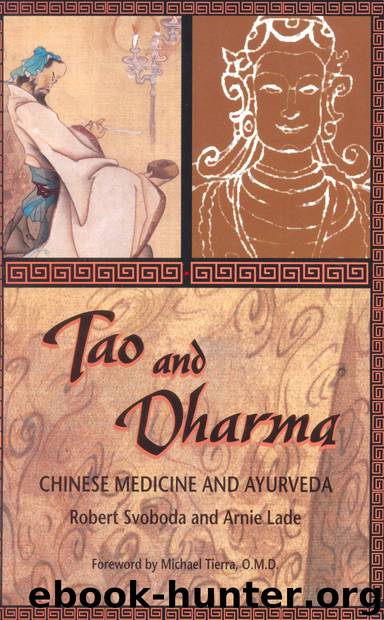Tao and Dharma by Svoboda & Arnie Lade

Author:Svoboda & Arnie Lade [Svoboda, Robert]
Language: eng
Format: epub
ISBN: 978-0-9149-5521-4
Publisher: Lotus Press
PART THREE
TRADITIONS IN COMPARISON
1
Historical Considerations
Both Indian and Chinese medicine are unique systems that arose independently, remaining intimately associated with their own indigenous religious and cultural perspectives. This, however, did not hinder the exchange of information and absorption of concepts and practices from one system to the other, or from other surrounding cultures. Tracing the exact routing and giving concrete dates to these transmissions of knowledge is extremely difficult, but certain general themes may nevertheless be inferred from the mass of information available.
An important historical event occurred sometime during the third or fourth century B.C. that clearly establishes that these two societies were indeed in communication with each other. At that time India already possessed a highly evolved literary society which had produced scores of texts on such topics as religion, astrology and medicine. The preeminent Ayurvedic text Charaka Samhita was already many hundred years old, while the landmark Yellow Emperor’s Inner Classic was only then being compiled in China. During this period reports started to circulate in China about soma, the psychotropic plant associated with mystical experiences which had occupied an important place in early Indian religion. In the Indian context the use of soma is known to have played a central role in the Rig Veda, a scripture that appeared prior to 1000 B.C.
Soma was promoted in China as possessing the power to bestow immortality, and the persistent and enticing reports eventually led Emperor Qin Shi (reigned 221-207 B.C.), first Emperor of a unified China, to order the procurement of this wondrous plant. Eventually, the Emperor himself went to the western mountains in an unsuccessful search. Despite this failure, the Emperor refused to give up, and apparently gave permission and support to a peculiar man named Su Fu, who was sent with a large contingent of virginal children on a sea voyage to bring back this divine substance. The first journey did not go well, and on Su Fu’s return, he was re-equipped and sent off again, but nothing more is known about this later mission.
The Chinese never did obtain soma, even though continuous efforts were made during the Han Dynasty (206 B.C-220 A.D.), and even today no one knows soma’s true identity, despite much search and speculation. This should not be surprising since according to Tantric tradition, there is no one “soma". Many different substances can be used as soma, if they are employed in the proper way at the proper time. This deep interest by the Chinese in soma did at least stimulate, and perhaps initiate the development of the Taoist alchemical arts. A momentous spin-off was an enthusiastic research into China’s own plants and minerals as well as the systemization of Internal Medicine. Clearly the mysterious soma kindled the interest of the Chinese in the lands to the west.
Other evidence suggests that there had been contacts between these two ancient Asian cultures before the 4th century B.C. There are for example some remarkable similarities between their ancient systems of astrology, including the division of the sky
Download
This site does not store any files on its server. We only index and link to content provided by other sites. Please contact the content providers to delete copyright contents if any and email us, we'll remove relevant links or contents immediately.
| Acupuncture & Acupressure | Aromatherapy |
| Ayurveda | Chelation |
| Chinese Medicine | Energy Healing |
| Healing | Herbal Remedies |
| Holistic | Homeopathy |
| Hypnotherapy | Massage |
| Meditation | Naturopathy |
| Reference |
Inner Engineering: A Yogi's Guide to Joy by Sadhguru(6633)
The Power of Now: A Guide to Spiritual Enlightenment by Eckhart Tolle(5544)
Fear by Osho(4619)
Ikigai by Héctor García & Francesc Miralles(4044)
The Art of Happiness by The Dalai Lama(4009)
The Ultimate Bodybuilding Cookbook by Kendall Lou Schmidt(3853)
Yoga Therapy by Mark Stephens(3668)
The Little Book of Hygge by Meik Wiking(3515)
The Healing Self by Deepak Chopra(3405)
Why Buddhism is True by Robert Wright(3372)
The Hatha Yoga Pradipika (Translated) by Svatmarama(3184)
Being Aware of Being Aware by Rupert Spira(3169)
Shift into Freedom by Loch Kelly(3098)
Wild Words from Wild Women by Stephens Autumn(3040)
Work Clean by Dan Charnas(3006)
Happiness by Matthieu Ricard(2958)
More Language of Letting Go: 366 New Daily Meditations by Melody Beattie(2940)
Yoga Body & Mind Handbook by Jasmine Tarkeshi(2809)
Why I Am Not a Feminist by Jessa Crispin(2665)
